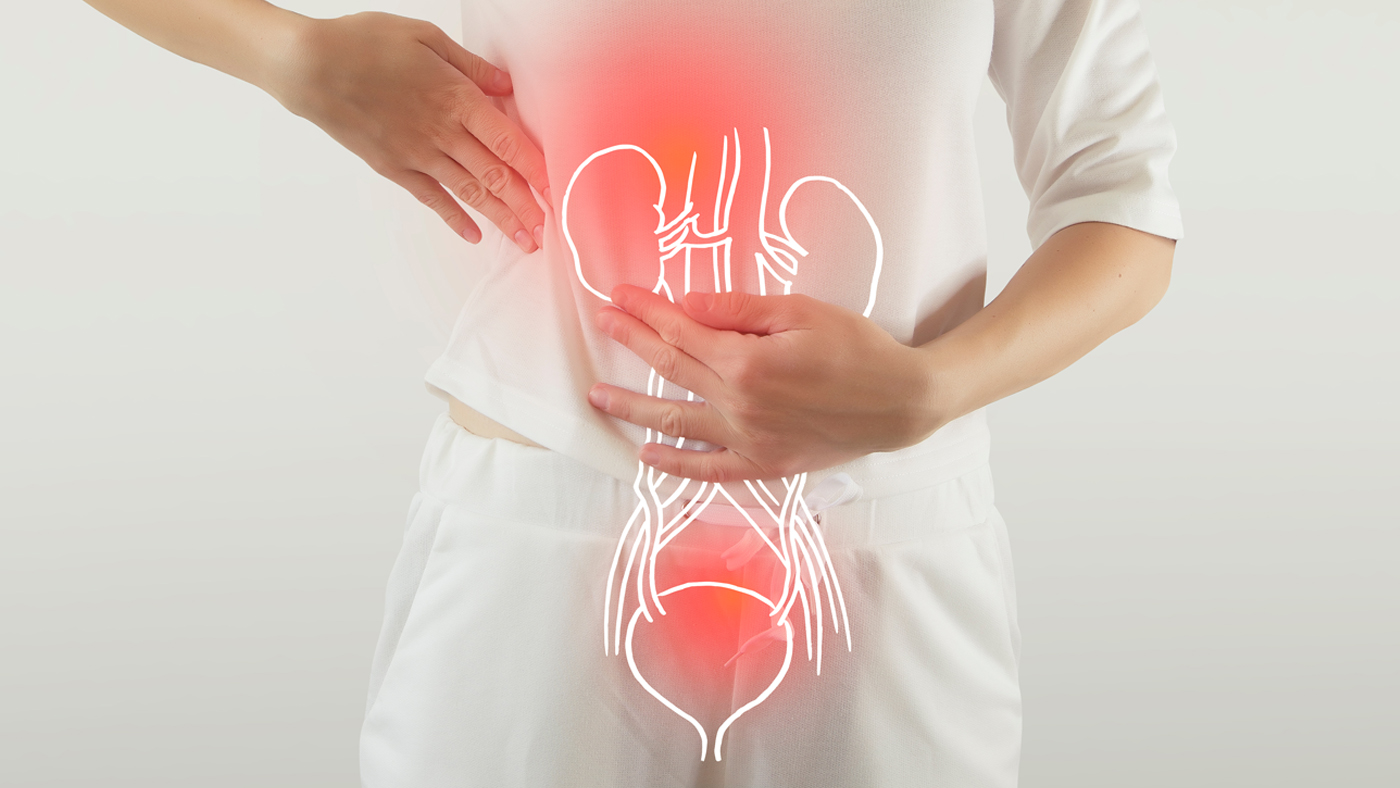What are Urinary Tract Infections (UTIs)?
Urinary tract infections (UTIs) occur when bacteria has a chance to grow in the urethra and bladder. Almost 90% of UTIs are caused by the bacteria Escherichia coli (E-Coli) and this bacterium is often present in our gut without causing any harm. Infections limited to the lower urinary tract can be very painful and troubling, but normally go away on their own after a few days. If not, treatment with antibiotics might be required. Like any other kind of infection, the longer it goes untreated, the more serious the complications can be. A symptomatic* UTI that goes untreated can eventually lead to kidney damage.
Not all urinary tract symptoms are UTIs, even if they may feel like one. If you suspect that you have a UTI, contact your doctor immediately – home cures or other remedies cannot, in most cases, eliminate the infection completely.
(*Symptomatic: with demonstrative symptoms such as fever, blood in urine, cloudy urine etc.)
Urinary Tract Infection Symptoms
A urinary tract infection usually involves a change in your urinating pattern. Signs that you may have a UTI include:
- Frequent urge to urinate
- Incontinence
- A burning sensation when emptying bladder
- Blood in urine
- Cloudy, discolored or smelly urine
- Lower back and abdominal pain
- Fever
- Feel generally unwell
Depending on which part of the urinary system that is infected by bacteria the signs and symptoms differ. Typical kidney infection symptoms are:
- High fever
- Chills or shaking
- Lower back pain or pain in the side of your back
- Nausea or vomiting
If you do get a urinary tract infection, it is easily treated. Contact your healthcare professional as soon as possible.

Causes of Urinary Tract Infections
A urinary tract infection typically occurs if bacteria travels along the urethra into the bladder, begins to multiply and causes tissue damage. The human body has defense mechanisms to protect against these invaders, but these defenses sometimes fail. The immune system varies between individuals, therefore the level of defense mechanisms differs. If the bacteria wins the battle over the body’s immune system, we will react with symptoms, e.g. pain and fever.
Watch this 3-minute animation to understand how a UTI occurs:
Intermittent catheterization (IC) reduces the risk of a UTI compared to other bladder management methods, e.g. indwelling catheters. However, the risk of developing a UTI is still present since bacteria from outside the body may enter the bladder via the urinary catheter. It’s important to select a hydrophilic catheter that completely empties the bladder and avoids risk of causing harm to the urethra.
The Difference Between a Bacteriuria and a Urinary Tract infection, UTI
Bacteriuria is presence of bacteria in urine without accompanying symptoms of a UTI, such as frequent urination, painful urination or fever. Bacteriuria is very common in people using IC. In fact, some studies show up to 60% of IC users have bacteriuria.
It is recommended to minimize the use of antibiotics in persons practicing IC due to potential antibiotic resistance and antibiotic side effects. Bacteriuria without symptoms should not be treated with antibiotics unless you are pregnant or have had a kidney transplant.
Who is More at Risk of Getting a Urinary Tract Infection (UTI)?
Urinary tract infections are more common in women than in men because of a number of reasons, e.g. shorter urethra makes it easier for bacteria to travel along the urethra and infect the bladder. Also the short distance between the anus and the urethral opening can increase risk of contamination as E.Coli are normally present in the gut and may migrate and lead to an infection.
Why Women are at Higher Risk of UTIs Than Men:
- Female anatomy, as the shorter urethra makes it easier for bacteria to reach the bladder.
- Sexual intercourse, because of potential transfer of bacteria (vagina close to rectum).
- Changes in vaginal flora, e.g. via the use of spermicides.
- Pregnancy due to hormonal changes etc.
- Menopause, with declining levels of estrogen.
General Risk Factors for UTIs, Related to Both Men and Women:
- Structural problems in the urinary tract e.g. abnormalities of the urinary tract from birth or enlarged prostate (in older men)
- A low immune system or when the body is coping with 2 or more diseases together
- Bowel dysfunction (constipation makes it more difficult to empty the bladder)
- Catheter use (anything inserted into the urethra, including surgical examinations performed at hospitals actually increase the risk of infection)
How to Avoid Urinary Tract Infections?
There are things you can do to reduce the risks of getting a UTI. Prophylactic (preventative) treatments, like drinking cranberry juice making the urine more acidic was initially thought to contribute to an antibacterial effect, but there is no solid scientific proof that this works.
The most important factor in UTI prevention is to inhibit the bacteria from attaching to the cell wall of the bladder. Cranberries contain a substance which have been shown in studies to be able to hinder the bacteria to attach. It’s only the whole cranberry fruit which shows this effect, not the juice.
People with a healthy and variable normal bacterial flora are shown to have the strongest defense mechanism against urinary tract infection. By adding probiotics (living microorganisms) the normal flora may grow and some studies suggest this as an attractive strategy to prevent infection.
Probiotics: means live bacteria found in certain foods or supplements. They can provide numerous health benefits.
Prebiotics: These substances come from types of carbs (mostly fiber) that humans can’t digest. The beneficial bacteria in your gut eat this fiber.
Other Proven Ways to Avoid UTIs:
Drink plenty of liquids: Drinking water helps dilute the urine and ensures that urination is done more frequently, allowing bacteria to be flushed away from the urinary tract and bladder before an infection can begin.
Wipe from front to back to avoid transfer of bacteria from rectum to the urethra (in females).
Urinate directly after having sex helps flush bacteria away from the urethra and bladder.
Avoid constipation, studies show that this may cause the bladder to not empty completely, leaving residual urine containing bacteria.
What are Risk Factors for Urinary Tract Infection (UTI) in Conjunction to Catheter Users?
Individuals who cannot empty their bladder in a natural way are dependent on catheterization. Intermittent catheterization (IC) is the gold standard and should always be chosen over indwelling catheters to prevent infections. The procedure mimics the body´s natural way of emptying and nothing remains in the body longer than the time needed to completely empty the bladder. This is of major importance to avoid infections. Indwelling catheters remain in the body for weeks or months and by having something in place inside the body this assists bacteria to attach and travel along this surface to the bladder and cause an infection. Individuals using indwelling catheters often get UTIs that are much harder to treat with regular antibiotics. This is because of more aggressive types of bacteria as well as different bacteria species present at the same time.
IC is the best way of emptying the bladder, for those who cannot urinate naturally. However, there is a risk of UTI and special attention needs to be taken to avoid this risk as much as possible.
Why Catheter Users Have a Higher Risk of UTIs:
- Risk of inserting foreign bacteria via the catheter
- Loss of natural flushing of the urethra while using a catheter (compared to natural urinating)
- Risk of the catheterization procedure making wounds in the urethra
- Remaining urine in the bladder due to incomplete emptying of the bladder, leaving residual urine containing bacteria
How to Avoid a UTI When You Use a Catheter:
Everything inserted into the urethra will potentially increase the risk of UTIs, therefore this is a topic of extra concern for these individuals. Important to know is that not all intermittent catheters are the same. By selecting a catheter with specific catheter requirements, and following some simple steps, the risk of UTIs can be minimized.
Hygeine
Wash your hands before each catheterization. The genital area can be washed with a mild soap once a day,but remember that washing more often can remove the natural good bacteria and mucosa that help fight infection.
Avoid touching the catheter tube, as this may contaminate its surface. Several LoFric catheters have an insertion aid or sterile handle that helps you insert the catheter tube without touching it.
Empty Your Bladder Completely and Often
Excess urine is often a cause of infection. Take your time when you catheterize. Withdraw the catheter slowly to ensure the bladder is empty.
It is important that your catheter is the right length – catheter tubes that are too short can leave residual urine, increasing the risk of developing a urinary tract infection. To ensure your catheter has the correct tube length, ask your doctor or nurse for advice.
Your healthcare professional will advise you on how often to catheterize each day. The general rule of thumb is to urinate 4–6 times a day at regular intervals. If you void more than 400 ml of urine at any interval, you are waiting too long. Studies have shown that a high volume of urine in the bladder increases the risk of UTIs.
Avoid Friction
Your urethra and bladder have natural mucosa that prevent bacteria from causing harm. Protecting this mucous will also help minimize the risk of urinary tract infection. LoFric hydrophilic catheter tubes have a surface that binds water. This makes the tube very slippery, preventing friction – and damage to the urethra mucosa – both when it goes in and when it comes out. In this way, hydrophilic catheters like LoFric, are proven to reduce the risk of urinary tract infection by 64%.1 Not all hydrophilic catheters are the same, so ask your doctor or nurse for help in choosing the hydrophilic catheter that’s right for you.
How are Urinary Tract Infections Treated?
Normally a UTI will go away by itself after a few days if there are no other underlying diseases. However, there are people who will need antibiotics to combat the infection. People getting frequent UTIs usually require specific treatment and for a severe UTI and/or effect on the kidneys, intravenous antibiotics in a hospital may be needed.
If a UTI is suspected, always speak with your healthcare provider.
Denise's story
Watch Denise talk about how using ISC helped combat her frequent bouts of UTI.
-
Treatment Options for Bladder Problems
In this section, we explore the treatment options available for bladder problems, one of which is catheters. Learn about the different types of catheters and how they are used.

-
Living with Bladder Problems
To live with a condition that requires you to catheterize on a regular basis may feel overwhelming in the beginning. Find comfort in the fact that you are not alone.

-
Female Bladder Health
Here we look at the importance of female bladder health and the reasons women are more prone than men to get UTIs.
